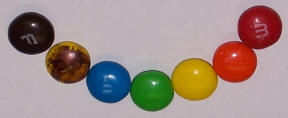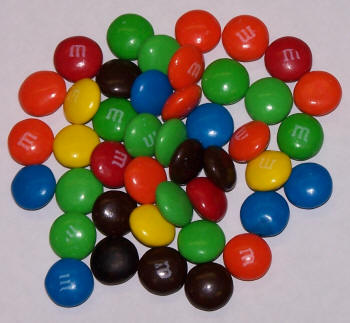RIKLBLOG
|
| Tomorrow |
| 17 Jan. 2007 |
| Yesterday |
| Index |
| Eventide |
| SETI League |
| PriUPS Project |
| Bonus! |
| Contact |
The Color of Ms

Yesterday I berated the Times for overstating our oil consumption by a factor of a million. And a million it was, by the way. I deliberately didn't look for a "correction" until today, and sure enough the "million" was spurious. Today, I temperately call into question a minor item in the Wall Street Journal. I'm certain it isn't off by a factor of a million. It may not be off at all, and I offer this blog as your opportunity to do some original research.
Tara Parker-Pope is the Journal's "Health" columnist, and her article Tuesday included a number of diet tips. She quoted extensively from a book by Dr. Brian Wansink called "Mindless Eating." In his book, based on his own research and that of others, Dr. Wansink lists several examples of what he calls "mindless eating." Among various "common sense" items such as eat more slowly and use smaller containers and plates was this gem:
Too much variety makes us overeat. In one experiment, snackers were given bowls of M&Ms with either seven colors or 10 colors. Snackers with 10 color options ate an average of 43 more candies than those with just seven colors to choose from.
The premise - too much variety makes us overeat - seems perfectly reasonable, if for no other reason than we want to "try everything." I'd be likely to eat more chocolate from a box with 20 varieties than I would from a bag of blob-like truffles. (Or at least eat more quickly, if only to prevent others from scarfing up a treat I might like.) But: Look at the actual numbers in the example above! Snackers ate an average of 43 more candies when the number of colors (not flavors!) was increased from 7 to ten.
 Observe,
if you will, "43 more candies." Even for a power-"snacker" such as
this blogger, that would appear to be quant. suff. for an average
consumption session. (For Science I might be willing to go a
little further, of course.) So what to make of the quotation from
the article?
Observe,
if you will, "43 more candies." Even for a power-"snacker" such as
this blogger, that would appear to be quant. suff. for an average
consumption session. (For Science I might be willing to go a
little further, of course.) So what to make of the quotation from
the article?
There are six standard colors in a "normal" bag of M&Ms*. Presumably a pre-determined number can be conveyed to a bowl and offered to a panoply of scientifically-selected subjects. After some period of snackage, the remainder can be enumerated and the average quantity consumed determined.
It is, I believe, well known that M&M flavor is invariant with respect to the reflective characteristics of the individual integuments. Thus, a witting participant in this experiment might be expected to exhibit a consistent consumption profile without regard to M color. Even a naive participant might, while testing each of the oblate experimental subjects, discover for himself this invariance and so disregard its spectral characteristics. An interpretation more favorable to the alleged outcome might assert that the superabundance of atypical M coloration might induce the snackers to at least sample each color M to determine if there is some unexpected novelty. But 43 additional candies? For only three additional colors? Even if there were only a straight-line increase in consumption based on the percentage increase of colors, it would imply that the base consumption would be 100 Ms for seven colors, increasing to 143 for 10 colors. Look again at the photo and decide for yourself if that is probable!
I don't consider myself a food expert. I'm certainly not versed in Mnology. (Although, as I have mentioned before, I do personally know a former director of the Good Housekeeping Institute.) I am, however, naturally skeptical of improbable numerical assertions. Just two weeks ago Ms. Parker-Pope told me (in her column) that I shouldn't be shoveling snow. Now, I see an assertion of exhorbitantly increased chocolate consumption. I fear I shall have to consider her future advice more critically!
*If you are as observant as I expect, you will have noticed that there are seven Ms in the top photograph, while I mentioned (after determining by careful examination) that there are only six colors in a normal assortment. If you looked even closer, you may have noticed that the M second from the left lacks the uniformity of coloring possessed by its conspecifics. Well spotted! Although I attempted to achieve an indigo coloration in honor of our old friend Mr. Biv, my success in that endeavor has been no greater than what I've achieved in drawing stick figures or anything else of an "artistic" nature. At least I can count.
NP: "Passion Play" - Jethro Tull
| © 2007 |
| Richard Factor |
